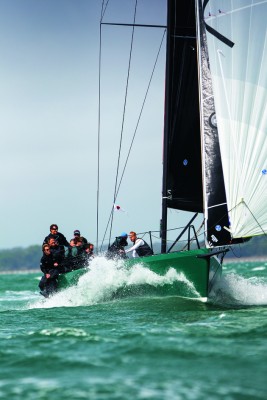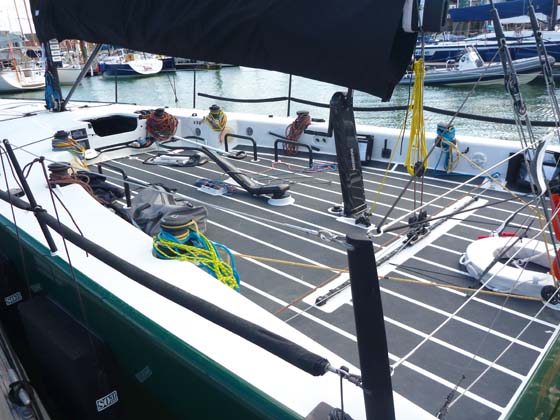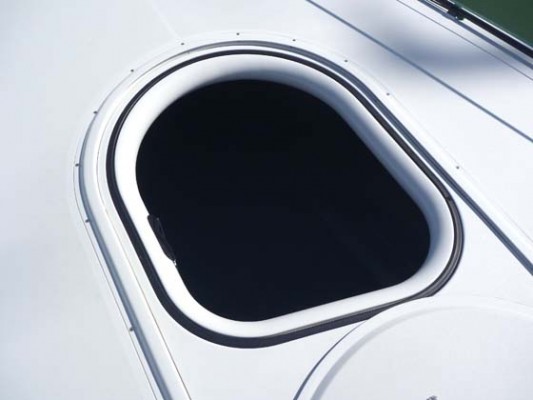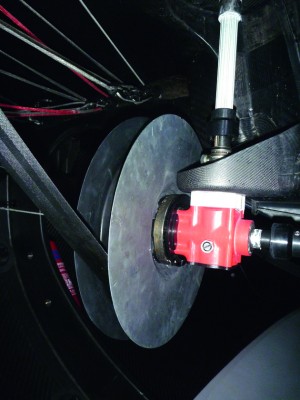Downwind performance is the USP of the new breed of 40-footers and the Carkeek-designed Rebellion is no exception. Matthew Sheahan goes aboard
Ask any owner of the new breed of grand-prix 40-footers about their boats and they will start by describing the downwind performance.
It’s hardly surprising. The new generation of lightweight, amply canvassed carbon machines have sail area:displacement ratios to make your toes tingle and their ballooning polar curves for downwind angles can trigger a shot of adrenalin just at the thought.
Stewart Whitehead is one of the latest to join the fleet. He took delivery of his Carkeek 40 MkII Rebellion in spring this year and, when I ask him about how he is getting on, his response is typical.
“We’ve certainly learned that the A4 is not the right sail in a breeze,” he says, recounting one of the windy days in the RYS Bicentenary regatta. “In 30 knots downwind, an A5 or A6 would have been better as it would have allowed me to heat her up a little bit more and steer her over the waves. As it was, we were piling through them and, with the tiller being quite far forward in the boat, I was submerged for a lot of the time. But hey, it was a superb fun.”
Rebellion is the second of the Carkeek 40 MkIIs to have been built by Dubai-based Premier Composites Technology (PCT). Designed by Shaun Carkeek, she’s a development of the US-based boats, Spookie and Decision, first-generation Carkeek 40s.
Boat for the modern era
With her plumb bow, beamy lines aft, radiused chine and a deck layout so clear and uncluttered it leaves you wondering whether she has been finished, the C40MkII is a boat of the modern era. She, like others in her class, takes many of her cues from developments that have trickled down from the TP52 and mini-maxi fleets where control line systems and deck layouts have been refined extensively in recent years.
She has a shallow cockpit, a fixed bowsprit, a towering two-spreader carbon rig with ECsix carbon rigging and a large square-top mainsail – in essence, a full-on racing package. Below decks she has a complex array of under deck control lines and hydraulics including the sophisticated spinnaker take down system.
Yet one thing that stands out over many others is the quality of her build, which is superb. And while this isn’t unusual for boats from PCT, it is yet another reminder of how high they have set the bar.
The bar has also been raised for Whitehead himself who, as an owner-driver, acknowledges the big step up from his previous boat, Rebel, the Farr 45 he owned for eight years and raced in what was then a competitive, Solent-based one-design fleet.
“Wheel steering is easier and it was an option on Rebellion, but as a former dinghy sailor I knew I’d have more feel with a tiller and wanted to make the step up to this kind of a boat. Threading your way around ten other crew and the chocks during tacks and gybes takes some practice though.”
He clearly enjoyed the nip and tuck of busy mark roundings in the closely matched 45s and yet his choice of the Carkeek 40 was not based on taking a punt on the next successful one-design.
Hopes of a level rating class
He moved to Rebellion to join a growing fleet of 40-footers from various designers and builders from which it is hoped a level rating class will develop. And as he describes how he and his crew have been working the boat up to speed, it becomes clear that owners like Whitehead are seeing the appeal of level-rating boats that can be tweaked and customised, while still retaining the ability to engage in close boat-on-boat racing.
Several configurations are available for the Carkeek 40 MkII, from a pre-preg carbon/epoxy/Nomex construction for the Grand Prix Custom spec to an infused E Glass/epoxy/foam sandwich construction costing around US$151,000 less for a boat that is skewed more towards IRC racing.
Whitehead’s starting point was to ensure that his boat could be competitive under a number of rating systems.
“I’ve been looking for two years to make the next step,” he explains. “And I’m glad that it took this time because the fleet has changed with the new breed. The boat was originally designed around the HPR rule and, while configuring it for IRC racing was an option at the early stage, I wanted a planing boat, so it didn’t make sense to then deliberately make it heavy.
“My original long-term plan was to race the boat at a variety of events at home and abroad, not just under IRC – another reason for not wanting to make the boat heavy.”
But while he still intends to take Rebellion to other events at some stage in the future, his current plans are to stick with the Solent fleet to help it build and this means a slight refocusing on IRC.
Refocusing on IRC
This, he says could mean adding a little weight to the bulb, but has already meant having his sails remeasured and the boat weighed. In addition, he’s looking at fitting a new rudder that is around 12 per cent bigger, although this is aimed more at providing greater control when the breeze starts to exceed 22-25 knots.
For his sail wardrobe, it has been the offshore races that have been the most revealing. “Our initial sail wardrobe included an A1.5, A2, A4, masthead [Code] 0 and fractional 0, and then I ordered an A6 for the Fastnet,” says Whitehead. “But during our offshore races this year we found we were using the fractional and masthead 0s a great deal of the time. Some call them luxury sails, but we think they’re essential offshore, especially the fractional 0 which is good in a breeze at 65° true with the genoa staysail set inside. Even if we have to put a reef in the mainsail it’s still a great combination.”
But when I ask him about the boat’s potential strengths against her competition, the conversation turns downwind once again: “We’re a lighter boat than some of the others so our gains should be downwind.”
You can’t blame him, or any of the owners; it’s what the new breed is all about. It only takes one ride to be hooked.
The one-pedestal grinding system aboard is mounted well aft, but just in front of the mainsheet traveller. Note how far forward the tiller steering is. “In a breeze there’s no one in front,” says owner-driver Stewart Whitehead
Self-gybing hobble – a simple strop running across the boat frees up the primary sheet winch downwind and allows the jib to gybe automatically. Height is set with the loose, adjustable splice
Simple shockcord system keeps the mainsheet traveller line from jamming under the car when eased to leeward
Clear evidence as to how many lines run under the deck – there are none to be seen on top
Looking aft through the immaculately finished carbon shell. The trampoline keeps the kite off the cabin sole ready for the next hoist
Moulded foredeck hatch for spinnaker launch/recovery. Radiused edge means no roller is required below decks. Hatch also has a pneumatic seal pumped in the cockpit
A-sail take down drum is driven by a pedestal on deck. The webbing strop running underneath ensures the line stays close to the drum, even when slack
Specifications
LOA 12.20m/40ft 0in
Beam 3.85m/12ft 7in
Draught 2.95m/9ft 8in
Sail area:
upwind 109m2/1,173ft2
downwind 249m2/2,680ft2
Displacement 3,850kg-4,150kg/8,470lb-9,310lb
Designed by Shaun Carkeek
Grand Prix Custom Edition
Pre-preg carbon/epoxy/Nomex sandwich construction.
From US$549,000 (£352,043)
Grand Prix Edition
Infused carbon/epoxy/foam sandwich. From $469,500 (£310,100)
Race Edition (IRC Optimised)
Infused E Glass/epoxy/foam sandwich. From $398,500 (£255,572)
All prices ex works ex VAT.













